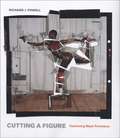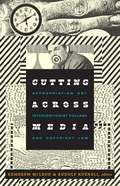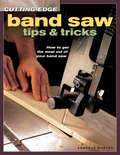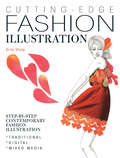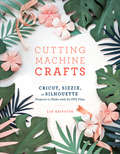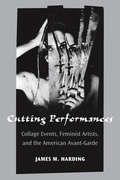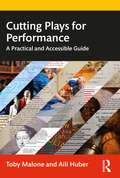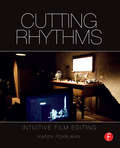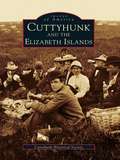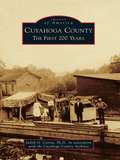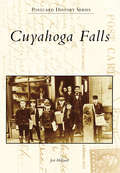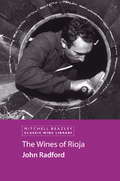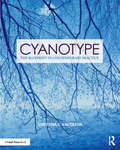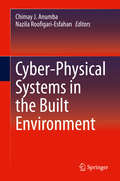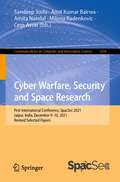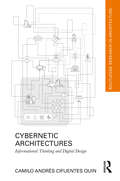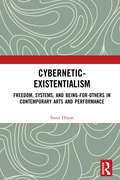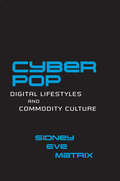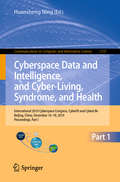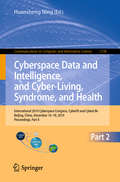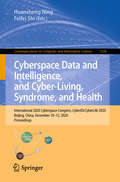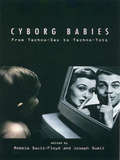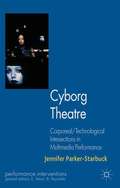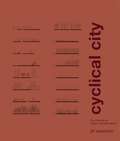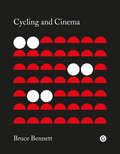- Table View
- List View
Cutting a Figure: Fashioning Black Portraiture
by Richard J. PowellExamining portraits of black people over the past two centuries, Cutting a Figure argues that these images should be viewed as a distinct category of portraiture that differs significantly from depictions of people with other racial and ethnic backgrounds. The difference, Richard Powell contends, lies in the social capital that stems directly from the black subject's power to subvert dominant racist representations by evincing such traits as self-composure, self-adornment, and self-imagining. Powell forcefully supports this argument with evidence drawn from a survey of nineteenth-century portraits, in-depth case studies of the postwar fashion model Donyale Luna and the contemporary portraitist Barkley L. Hendricks, and insightful analyses of images created since the late 1970s. Along the way, he discusses major artists-- such as Frédéric Bazille, John Singer Sargent, James Van Der Zee, and David Hammons--alongside such overlooked producers of black visual culture as the Tonka and Nike corporations. Combining previously unpublished images with scrupulous archival research,Cutting a Figure illuminates the ideological nature of the genre and the centrality of race and cultural identity in understanding modern and contemporary portraiture.
Cutting Across Media: Appropriation Art, Interventionist Collage, and Copyright Law
by Kembrew Mcleod Rudolf KuenzliIn this collection of essays, leading academics, critics, and artists historicize collage and appropriation tactics that cut across diverse media and genres. They take up issues of appropriation in the popular and the avant-garde, in altered billboards and the work of the renowned painter Chris Ofili, in hip-hop and the compositions of Bla Bartk and Zoltn Kodly, and in audio mash-ups, remixed news broadcasts, pranks, culture jamming, and numerous other cultural forms. The borrowing practices that they consider often run afoul of intellectual property regimes, and many of the contributors address the effects of copyright and trademark law on creativity. Among the contributors are the novelist and essayist Jonathan Lethem, the poet and cultural critic Joshua Clover, the filmmaker Craig Baldwin, the hip-hop historian Jeff Chang, the 'zine-maker and sound collage artist Lloyd Dunn, and Negativland, the infamous collective that was sued in 1991 for sampling U2 in a satirical sound collage. Cutting Across Media is both a serious examination of collage and appropriation practices and a celebration of their transformative political and cultural possibilities. Contributors Craig Baldwin David Banash Marcus Boon Jeff Chang Joshua Clover Lorraine Morales Cox Lloyd Dunn Philo T. Farnsworth Pierre Joris Douglas Kahn Rudolf Kuenzli Rob Latham Jonathan Lethem Carrie McLaren Kembrew McLeod Negativland Davis Schneiderman David Tetzlaff Gbor Vlyi Warner Special Products Eva Hemmungs Wirtn
Cutting-Edge Band Saw Tips & Tricks: How To Get The Most Out Of Your Band Saw (Cutting Edge Ser.)
by Kenneth Burton15 Must-Have Jigs and FixturesIt's time to unleash the full power of your band saw. With Cutting-Edge Band Saw Tips & Tricks, you'll learn how to build 15 jigs and fixtures that will turn your band saw into the most useful tool in the shop. These essential accessories are easy to create with the complete step-by-step photos and instructions inside this book.No matter what you want to build, the techniques found here will make the construction process easier and the finished product better. You'll also find full plans for three gorgeous projects - all designed to harness the muscle of your new jigs and fixtures. Don't miss this chance to use your band saw in ways you never thought you could!
Cutting Edge Fashion Illustration
by Erica SharpCutting-Edge Fashion Illustration is the go-to resource and inspiration if you're a budding fashion designer, fashion illustrator or just simply want to learn more illustration techniques.Covers all key areas of illustration using traditional, digital and mixed media methods, offering clear advice on how to manage color, textures, patterns and how to create your own fashion portfolio.Easy to follow step-by-step tutorials demonstrate each of the techniques, followed by a gallery of inspirational images show how to use each technique in your own illustrations.Erica is a fashion illustrator working with key fashion publications in London, UK, one of the world's leading cities of fashion, so her style is very commercial and current!
Cutting Machine Crafts with Your Cricut, Sizzix, or Silhouette: Die Cutting Machine Projects to Make with 60 SVG Files
by Lia GriffithGet more creative with your Cricut, Sizzix, or Silhouette die cutting machine! Here are 50 easy projects and 60 templates for making gorgeous home accessories, fun party decor, and memorable gifts. This book includes beautiful items you can make using just about any electronic die cutting machine, by downloading the SVG templates, running your materials through your machine, and following the instructions to assemble your cut materials. Discover graphic Scandinavian patterns to decorate aprons and tea towels, paper succulent centerpieces, and dozens of blooms for bouquets, garlands, and crowns. Every project includes easy instructions and plenty of variations so you can get the most out of your machine. With an introduction to electronic die cutting machines and options for cutting the templates out by hand, this book is full of inspiration and expert advice.Includes instructions for downloading 60 SVG cut files compatible with most electronic cutting machines.
Cutting Performances: Collage Events, Feminist Artists, and the American Avant-Garde
by James M. Harding"A thoughtful and engaging contribution to the field that will have a sustained and lasting impact on the way feminist performance is defined and understood, as well as on how feminist histories and historiographies continue to challenge and transform the larger field of performance. " ---Charlotte Canning, The University of Texas at Austin. "Harding forcefully challenges and destabilizes the male-centered Eurocentric genealogy of the avant-garde, which he claims is an uncontested, linear, positivistic history, unproblematized by theory. Then he argues that this gendered biased version of the European avant-garde is carried over into American historiography . . . A forceful case for a revisionist history. " ---Daniel Gerould, The City University of New York Graduate Center Cutting Performanceschallenges four decades' worth of scholarship on the American avant-garde by offering a provocative reconceptualization of the history of avant-garde performance along feminist lines. Focusing on five women artists (Elsa von Freytag-Loringhoven, Gertrude Stein, Yoko Ono, Carolee Schneemann, and Valerie Solanas) whose performance aesthetics made prominent use of collage techniques, James M. Harding sheds light on the cultural history of the avant-garde and the role that experimental women artists played in that history. He investigates the prominent position that collage technique occupied within the artists' performance aesthetic, and the decisively feminist inflection that their work gives to collage as a mode of avant-garde expression. The radical juxtapositions in their works produce the powerful effects of making the familiar strange and establishing contexts from which new understandings may emerge. Harding examines the performative dimensions of collage in experimental, feminist redefinitions of the literary, graphic, and theatrical arts, filling a void in a scholarly discourse that, while ostensibly about the vanguard, has lagged well behind other significant theoretical and historiographical currents. Cutting Performancesnot only challenges assumptions that have governed scholarship on the American avant-garde but also establishes a context to rethink the history of American avant-garde performance along feminist lines. It will appeal to audiences interested in theater history and performance studies as well as those interested in the cultural history of the avant-garde and the role that feminist experimental artists have played in it. James M. Harding is Professor of English at the University of Mary Washington. His other books includeNot the Other Avant-Garde: Transnational Foundations of Avant-Garde Performance(with John Rouse);Restaging the Sixties: Radical Theaters and Their Legacies(with Cindy Rosenthal); andContours of the Theatrical Avant-Garde: Performance and Textuality. Illustration: Carolee Schneemann inEye Body-36 Transformative Actions(1963) Action for camera (Photograph by Erró). Reproduced by permission of Carolee Schneemann.
Cutting Plays for Performance: A Practical and Accessible Guide
by Toby Malone Aili HuberCutting Plays for Performance offers a practical guide for cutting a wide variety of classical and modern plays. This essential text offers insight into the various reasons for cutting, methods to serve different purposes (time, audience, story), and suggests ways of communicating cuts to a production team. Dealing with every aspect of the editing process, it covers structural issues, such as plot beats, rhetorical concepts, and legal considerations, why and when to cut, how to cut with a particular goal in mind such as time constraints, audience and storytelling, and ways of communicating cuts to a production team. A set of practical worksheets to assist with the planning and execution of cuts, as well as step-by-step examples of the process from beginning to end in particular plays help to round out the full range of skills and techniques that are required when approaching this key theatre-making task. This is the first systematic guide for those who need to cut play texts. Directors, dramaturgs, and teachers at every level from students to seasoned professionals will find this an indispensable tool throughout their careers.
Cutting Rhythms: Intuitive Film Editing
by Karen PearlmanThere are many books on the technical aspects of film and video editing. Much rarer are books on how editors think and make creative decisions. Filled with timeless principles and thought-provoking examples from a variety of international films, the second edition of Karen Pearlman's Cutting Rhythms offers an in-depth study of the film editor's rhythmic creativity and intuition, the processes and tools editors use to shape rhythms, and how rhythm works to engage audiences in film. While respecting the importance of intuitive flow in the cutting room, this book offers processes for understanding what editing intuition is and how to develop it. This fully revised and updated edition contains: New chapters on collaboration and "editing thinking"; Advice on making onscreen drafts before finalizing your story Tips on how to create and sustain audience empathy and engagement; Explanations of how rhythm is perceived, learned, practiced and applied in editing; Updated discussions of intuition, structure and dynamics; An all-new companion website (www.focalpress.com/cw/pearlman) with video examples and links for expanding and illustrating the principles of key chapters in the book.
Cuttyhunk and the Elizabeth Islands (Images of America)
by Cuttyhunk Historical SocietyFive of the Elizabeth Islands-Naushon, Pasque, Nashawena, Cuttyhunk, and Penikese-date from 1602, when the Englishman Bartholomew Gosnold explored the waters of Vineyard Sound and Buzzards Bay aboard his ship the Concord. Although the small encampment Gosnold built on Cuttyhunk for trading with the Wampanoags was used for only a few weeks, journals kept by two crew members have survived and give vivid accounts of that voyage. Naushon, Pasque, and Nashawena are currently privately owned. Penikese, once a leper colony, is now the site of a school for troubled boys. Cuttyhunk is now the only island with a village center and easy public access. Captivating photographs and postcards in Cuttyhunk and the Elizabeth Islands trace the special experience of island life from the unspoiled habitat of Gosnold's time to the first invasion of summer folk in the 1950s. These vintage images not only show how the islands' rock-strewn landscapes reflect the hard lives of the early islanders but also attest to the pleasures of picnics and boating as tourism and summer residents brought a modest degree of prosperity. Many previously unpublished photographs of large estates on Naushon portray a life of privilege. Views of Penikese depict the barren dormitories of the lepers who lived out their lives there.
Cuyahoga County: The First 200 Years (Images of America)
by Cuyahoga County Archives Judith G. CetinaCuyahoga County, located on the shores of Lake Erie and the banks of the Cuyahoga, has recently marked its bicentennial, celebrating two centuries of history and achievement. From the county's creation in 1808, to the World War II era and beyond, Cuyahoga County was transformed from a frontier community into a vibrant urban center. Today this part of northeastern Ohio is envied for its distinctive neighborhoods, embrace of various religious creeds, resilient entrepreneurship, ethnically and racially diverse population, political leadership, recreational facilities, splendid cultural and educational institutions, storied sports franchises, and distinguished health facilities. Cuyahoga County government and its citizens are also renowned for their philanthropy and concern for those most vulnerable; championing ideals that ensure everyone an equal place at the table and freedom everywhere. This worldview was rooted in the actions of those who, throughout the centuries, risked their lives and fortunes to attain these goals, giving greater meaning to the area's Underground Railroad code name: HOPE.
Cuyahoga Falls (Postcard History Series)
by Jeri HollandWelcome to Cuyahoga Falls, Ohio, a small American town that epitomizes America itself. With a history dating back to the rough decades when the land was a deep wilderness inhabited by natives and adventure-seeking Europeans, the town grew into an industrial juggernaut, weathered disasters, embraced inventiveness, and spearheaded progress. Between these covers readers will find a treasure trove of postcards from a colorful past. From grand old buildings and daily town life to the natural beauty and resources of the Cuyahoga River, the images in Postcard History Series: Cuyahoga Falls reflect memories of Americana and times long since past.
Cwl Wines Of Rioja Ebook
by John RadfordOver the last decade, Spain’s most classic and widely recognized wine region,Rioja, has experienced a tumultuous evolution in its wine industry. This bookdocuments the changes in wine law, the heated debates between the networkof estates, bodegas, and growers, and the problems of overproduction. All aspectsof the wines of Rioja are covered in detail – from the traditional estates to the mostinnovative bodegas to the newest styles of red and white wines available. Thereare comprehensive, indepth profiles of producers and their wines, with opinions and observations from the world’s most recognized expert on Spanish wine.
Cyanotype: The Blueprint in Contemporary Practice (Contemporary Practices in Alternative Process Photography)
by Christina Z AndersonCyanotype: The Blueprint in Contemporary Practice is a two part book on the much admired blue print process. Part One is a comprehensive how-to on the cyanotype process for both beginner and advanced practitioners, with lots of photographs and clear, step-by-step directions and formulas. Part Two highlights contemporary artists who are using cyanotype, making work that ranges from the photographic to the abstract, from the traditional to the conceptual, with tips on their personal cyanotype methods alongside their work. These artists illustrate cyanotype’s widespread use in contemporary photography today, probably the most of any alternative process. Book features include: A brief discussion of the practice of the process with some key historical points How to set up the cyanotype ÒdimroomÓ The most extensive discussion of suitable papers to date, with data from 100+ papers Step-by-step digital negative methods for monochrome and duotone negatives Chapters on classic, new, and other cyanotype formulas Toning to create colors from yellow to brown to violet Printing cyanotype over palladium, for those who want to temper cyanotype’s blue nature Printing cyanotype on alternate surfaces such as fabric, glass, and wood More creative practice ideas for cyanotype such as handcoloring and gold leafing Troubleshooting cyanotype, photographically illustrated Finishing, framing, and storing cyanotype Contemporary artists’ advice, techniques, and works Cyanotype is backed with research from 120 books, journals, and magazine articles from 1843 to the present day. It is richly illustrated with 400 photographs from close to 80 artists from 14 countries. It is a guide for the practitioner, from novice to expert, providing inspiration and proof of cyanotype’s original and increasing place in historical and contemporary photography.
Cyber-Physical Systems in the Built Environment
by Chimay J. Anumba Nazila Roofigari-EsfahanThis book introduces researchers and practitioners to Cyber-Physical Systems (CPS) and its applications in the built environment. It begins with a fundamental introduction to CPS technology and associated concepts.It then presents numerous examples of applications from managing construction projects to smart transportation systems and smart cities. It concludes with a discussion of future directions for CPS deployment in the construction, operation and maintenance of constructed facilities. Featuring internationally recognized experts as contributors, Cyber-Physical Systems in the Built Environment, is an ideal resource for engineers, construction managers, architects, facilities managers, and planners working on a range of building and civil infrastructure projects.
Cyber Warfare, Security and Space Research: First International Conference, SpacSec 2021, Jaipur, India, December 9–10, 2021, Revised Selected Papers (Communications in Computer and Information Science #1599)
by Sandeep Joshi Amit Kumar Bairwa Amita Nandal Milena Radenkovic Cem AvsarThis book sonstitutes selected papers from the first International Conference on Cyber Warfare, Security and Space Research, SpacSec 2021, held in Jaipur, India, in December 2021.The 19 full and 6 short papers were thoroughly reviewed and selected from the 98 submissions. The papers present research on cyber warfare, cyber security, and space research area, including the understanding of threats and risks to systems, the development of a strong innovative culture, and incident detection and post-incident investigation.
Cybernetic Architectures: Informational Thinking and Digital Design (Routledge Research in Architecture)
by Camilo Andrés Cifuentes QuinFor the past 50 years, the advancements of technology have equipped architects with unique tools that have enabled the development of new computer-mediated design methods, fabrication techniques, and architectural expressions. Simultaneously, in contemporary architecture new frameworks emerged that have radically redefined the traditional conceptions of design, of the built environment, and of the role of architects. Cybernetic Architectures argues that such frameworks have been constructed in direct reference to cybernetic thinking, a thought model that emerged concurrently with the origins of informatics and that embodies the main assumptions, values, and ideals underlying the development of computer science. The book explains how the evolution of the computational perspective in architecture has been parallel to the construction of design issues in reference to the central ideas fostered by the cybernetic model. It unpacks and explains this crucial relationship, in the work of digital architects, between the use of information technology in design and the conception of architectural problems around an informational ontology. This book will appeal to architecture students and scholars interested in understanding the recent transformations in the architectural landscape related to the advent of computer-based design paradigms.
Cybernetic-Existentialism: Freedom, Systems, and Being-for-Others in Contemporary Arts and Performance
by Steve DixonCybernetic-Existentialism: Freedom, Systems, and Being-for-Others in Contemporary Arts and Performance offers a unique discourse and an original aesthetic theory. It argues that fusing perspectives from the philosophy of Existentialism with insights from the ‘universal science’ of cybernetics provides a new analytical lens and deconstructive methodology to critique art. In this study, Steve Dixon examines how a range of artists’ works reveal the ideas of Existentialist philosophers including Kierkegaard, Camus, de Beauvoir, and Sartre on freedom, being and nothingness, eternal recurrence, the absurd, and being-for-others. Simultaneously, these artworks are shown to engage in complex explorations of concepts proposed by cyberneticians including Wiener, Shannon, and Bateson on information theory and ‘noise’, feedback loops, circularity, adaptive ecosystems, autopoiesis, and emergence. Dixon’s groundbreaking book demonstrates how fusing insights and knowledge from these two fields can throw new light on pressing issues within contemporary arts and culture, including authenticity, angst and alienation, homeostasis, radical politics, and the human as system.
Cyberpop: Digital Lifestyles and Commodity Culture (Routledge Studies in New Media and Cyberculture #Vol. 3)
by Sidney Eve MatrixCyberpop is an analysis of cyberculture and its popular cultural productions. The study begins with a Foucaultian model of cyberculture as a discursive formation, and explains how some key concepts (such as 'virtuality,' 'speed,' and 'Connectivity') operate as a conceptual architecture network linking technologies to information and individual subjects. The chapters then each focus on a particular cyberfiguration, including Hollywood films (GATTACA, The Matrix), popular literature (William Gibson's Neuromancer, Scott Westerfeld's Polymorph), advertising for digital products and services (Apple Computer's '1984/McIntosh' campaign, AT&T's 'mLife' campaign), digital artworks (including virtual females such as Motorola's 'Mya' and Elite Modeling Agency's 'Webbie Tookay,' and work by visual artist Daniel Lee for Microsoft's 'Evolution' campaign), and video games (Tomb Raider). Each close reading illustrates the ways in which representations of digital lifestyles and identities - which typically fetishize computers and celebrate a 'high tech' aesthetic encourage participation in digital capitalism and commodity cyberculture. Matrix argues that popular representations of cyberculture often function as forms of social criticism that creatively inspire audiences to 'think different' (in the words of Mac advertising) about the consequences of the digitalization of everyday life.
Cyberspace Data and Intelligence, and Cyber-Living, Syndrome, and Health: International 2019 Cyberspace Congress, CyberDI and CyberLife, Beijing, China, December 16–18, 2019, Proceedings, Part I (Communications in Computer and Information Science #1137)
by Huansheng NingThis two-volume set (CCIS 1137 and CCIS 1138) constitutes the proceedings of the Third International Conference on Cyberspace Data and Intelligence, Cyber DI 2019, and the International Conference on Cyber-Living, Cyber-Syndrome, and Cyber-Health, CyberLife 2019, held under the umbrella of the 2019 Cyberspace Congress, held in Beijing, China, in December 2019. The 64 full papers presented together with 18 short papers were carefully reviewed and selected from 160 submissions. The papers are grouped in the following topics: Cyber Data, Information and Knowledge; Cyber and Cyber-enabled Intelligence; Communication and Computing; Cyber Philosophy, Cyberlogic and Cyber Science; and Cyber Health and Smart Healthcare.
Cyberspace Data and Intelligence, and Cyber-Living, Syndrome, and Health: International 2019 Cyberspace Congress, CyberDI and CyberLife, Beijing, China, December 16–18, 2019, Proceedings, Part II (Communications in Computer and Information Science #1138)
by Huansheng NingThis two-volume set (CCIS 1137 and CCIS 1138) constitutes the proceedings of the Third International Conference on Cyberspace Data and Intelligence, Cyber DI 2019, and the International Conference on Cyber-Living, Cyber-Syndrome, and Cyber-Health, CyberLife 2019, held under the umbrella of the 2019 Cyberspace Congress, held in Beijing, China, in December 2019. The 64 full papers presented together with 18 short papers were carefully reviewed and selected from 160 submissions. The papers are grouped in the following topics: cyber data, information and knowledge; cyber and cyber-enabled intelligence; communication and computing; cyber philosophy, cyberlogic and cyber science; and cyber health and smart healthcare.
Cyberspace Data and Intelligence, and Cyber-Living, Syndrome, and Health: International 2020 Cyberspace Congress, CyberDI/CyberLife 2020, Beijing, China, December 10–12, 2020, Proceedings (Communications in Computer and Information Science #1329)
by Huansheng Ning Feifei ShiThis volume constitutes the proceedings of the Forth International Conference on Cyberspace Data and Intelligence, Cyber DI 2020, and the International Conference on Cyber-Living, Cyber-Syndrome, and Cyber-Health, CyberLife 2020, held under the umbrella of the 2020 Cyberspace Congress, held in Beijing, China, in December 2020.*The 13 full papers presented were carefully reviewed and selected from 36 submissions. The papers are grouped in the following topics: machine learning and ubiquitous and intelligent computing. * The conference was held virtually due to the COVID-19 pandemic.
Cyborg Babies: From Techno-Sex to Techno-Tots
by Robbie Davis-Floyd Joseph DumitFrom fetuses scanned ultrasonically to computer hackers in daycare, contemporary children are increasingly rendered cyborg by their immersion in technoculture. As we are faced with reproductive choices connected directly with technologies, we often have trouble gaining perspective on our own cultural co-dependency with these very same technologies. Our notions of fetal health, maternal risk and child IQ are inseparable from them. Cyborg Babies tracks the process of reproducing children in symbiosis with pervasive technology and offers a range of perspectives, from resistance to ethnographic analysis to science fiction. Cultural anthropologists and social critics offer cutting-edge ethnographies, critiques, and personal narratives of cyborg conceptions (sperm banks, IVF, surrogacy) and prenatal (mis)diagnosis (DES, ultrasound, amniocentesis); the technological de- and reconstruction of birth in the hospital (electronic fetal monitors, epidurals); and the effects of computer simulation games and cyborg toys and stories on children's emergent consciousness. Contributors include Janet Isaacs Ashford, Elizabeth Cartwright, David Chamberlain, Jennifer Croissant, Charis M. Cussins, Robbie Davis-Floyd, Joseph Dumit, Eugenia Georges, Anne Hill, Mizuko Ito, Emily Martin, Steven Daniel Mentor, Janneli F. Miller, Lisa Mitchell, Lisa Jean Moore, Rayna Rapp, Matthew A. Schmidt, Syvia Sensiper, Elizabeth Roberts and Sherry Turkle. Examining the increasing cyborgification of the American child, from conception through birth and beyond, Cyborg Babies considers its implications for human cultural and psychological evolution.
Cyborg Theatre
by Jennifer Parker-StarbuckThis book articulates the first theoretical context for a 'cyborg theatre,' metaphorically integrating on-stage bodies with the technologized, digitized, or mediatized, to re-imagine subjectivity for a post-human age. It covers a variety of examples, to propose new theoretical tools for understanding performance in our changing world.
Cyclical City: Five Stories of Urban Transformation
by Jill DesiminiAs cities evolve and resources shift with time, spaces within those cities are often left fallow and abandoned. Cyclical City tells the stories behind these sites, from Philadelphia’s Liberty Lands park to Lisbon’s Green Plan, and it looks at the ways in which these narratives can be leveraged toward future engagement and use. Jill Desimini posits a fundamental role for spatial design practice to transform abandoned urban landscapes through time. She argues for approaches that promote the specific affordances of the land itself (hydrology, vegetation, topography, geology, infrastructural capacity, occupation potential); the importance of cyclical change; and the particularities of the cultural, political, and physical context. These themes are explored in five cities—Philadelphia, Berlin, Lisbon, Amsterdam, and Saint Louis—and across centuries, from periods of great upheaval to ones of relative stability and even economic growth. Desimini considers what landscape-driven design can bring to cities losing people and economic resources, how design practice can be more inclusive in a context of market failure, and the ways in which abandoned landscapes can become our commons.Preparation of this volume has been supported by Furthermore: a program of the J. M. Kaplan Fund
Cycling and Cinema (Goldsmiths Press Ser.)
by Bruce BennettA unique exploration of the history of the bicycle in cinema, from Hollywood blockbusters and slapstick comedies to documentaries, realist dramas, and experimental films.Cycling and Cinema explores the history of the bicycle in cinema from the late nineteenth century through to the present day. In this new book from Goldsmiths Press, Bruce Bennett examines a wide variety of films from around the world, ranging from Hollywood blockbusters and slapstick comedies to documentaries, realist dramas, and experimental films, to consider the complex, shifting cultural significance of the bicycle. The bicycle is an everyday technology, but in examining the ways in which bicycles are used in films, Bennett reveals the rich social and cultural importance of this apparently unremarkable machine. The cinematic bicycles discussed in this book have various functions. They are the source of absurd comedy in silent films, and the vehicles that allow their owners to work in sports films and social realist cinema. They are a means of independence and escape for children in melodramas and kids' films, and the tools that offer political agency and freedom to women, as depicted in films from around the world.In recounting the cinematic history of the bicycle, Bennett reminds us that this machine is not just a practical means of transport or a child's toy, but the vehicle for a wide range of meanings concerning individual identity, social class, nationhood and belonging, family, gender, and sexuality and pleasure. As this book shows, two hundred years on from its invention, the bicycle is a revolutionary technology that retains the power to transform the world.
